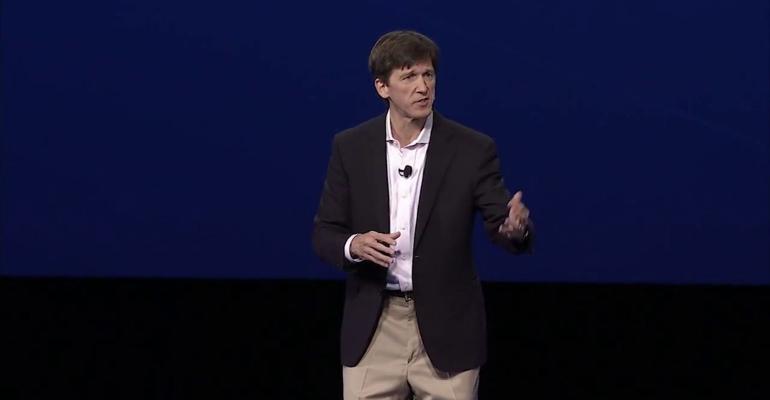On a call with home-office leaders in late February, LPL Financial CEO Dan Arnold laid out a plan to overhaul the independent broker/dealer’s culture and approach to working with advisors, citing its struggle to recruit advisors from the National Planning Holdings acquisition and a growing dissatisfaction among its own advisors.
Arnold also challenged employees to deliver 100 wins in 100 days, starting March 1. Whether he meant new advisor recruits or new capabilities is unknown. An LPL spokesman did not return a call seeking comment.
Listen to the call
“If we deliver 100 wins, we’ll begin to eliminate some of the friction—not all of it,” Arnold said. “We’ll begin to modernize some of the policies and procedures that will show up as a simplification in our daily interactions with our advisors. So if we begin to build momentum for ourselves and we begin to start getting wins and our advisors begin to see this occurring, then I think this is just the start of something much greater.”
What prompted Arnold’s plan was feedback the company was hearing from NPH advisors as well as existing LPL advisors.
“First and foremost, it ended up being way too difficult to recruit NPH advisors,” Arnold said on the call, obtained by WealthManagement.com. “In fact, we were hearing from them that we were just too big. I’m not sure ‘too big’ was really what they meant at the end of the day. I think if you look underneath that, it’s just other words for really saying, ‘You’re too big to deliver good personal service, and that’s your reputation out in the marketplace.’”
A number of prominent teams chose to join competitors of LPL’s instead of coming over as part of the acquisition.
LPL Financial said on its fourth quarter conference call that, so far, $34 billion in assets and close to 1,000 advisors out of a total 3,200 have transferred over from NPH. LPL executives said they expect to retain some 70 percent of the NPH advisors, or $70 to $75 billion, of NPH’s $105 billion in reportable assets. Spokeswoman Rachel White said the firm had no further updates on those comments as of the end of February.
Since then, WealthManagement.com reported that the firm launched an enhanced recruiting program, offering advisors at some rival firms 50 basis points on assets if they join the firm’s corporate RIA and 40 basis points on assets to join hybrid offices of supervisory jurisdiction.
The firm’s own advisors have complained about its declining service levels, and some fear it will only get worse with the addition of NPH reps.
“We also had data from our advisors through surveys and through our NPS [National Promoter Score] programs that were basically telling us the same thing, that not only were they struggling with our service levels, but their satisfaction had actually declined throughout the year,” Arnold said on the leadership call. “Clearly that was indicative of, we have a problem.”
Arnold said there were some aspects of the company culture going back to when it was founded that could be holding the firm back and creating resistance in how they want to serve advisors.
“So when you looked at our priorities, they tended to be a product of us being a much smaller, more vulnerable company, where we were focused on mainly managing our risk, rather than necessarily helping make life easier for our advisors,” he said.
But the business has changed. One example is the firm’s approach to dealing with problems. Historically, when something went wrong, the firm would deploy a group of people to put out the fire, so to speak.
“This may have worked when we had 1,000 advisors, 2,000, maybe even 3,000 advisors—which takes us back to, I don’t know, circa 2004/2005—but it doesn’t work for 15,000 advisors,” Arnold said. “That hero culture or that hero approach of trying to put out fires not only doesn’t work at this scale, it tends to just sort of solve the issue in the moment, and you’re actually never really improving or solving the real problem that’s underneath. So you don’t get better.”
Arnold’s plan focuses on three things: innovation, ease of doing business and leadership. By innovation, he means new capabilities to help advisors do business and new things that advisors may use to differentiate their practices with investors.
But in order to accomplish this, the firm must move faster.
“Where we’ve historically thought about things in years—and we have multi-year strategies—those are now obsolete,” he said. “We need to start thinking in months.”
He’s charged Dimple Shah, executive vice president of strategy, and her team with creating a four-step process that employees can use to innovate.
When speaking about the ease of doing business, Arnold uses Apple, Amazon and Alexa as examples of creating a simple user experience.
“When you think about those as examples, it is clear that we are not good at simple,” Arnold said. “I think if you ask advisors, they might even tell you we specialize in throwing complexity at them.”
Incremental changes the firm has been making to its systems aren’t moving the needle. For example, the firm’s initial objective in creating ClientWorks, its advisor workstation, was to just to create a better version of its old workstation, BranchNet.
“A better objective would’ve started with the desire to construct the simplest, most user-friendly platform possible for advisors,” he said. “And that’s the type of outcome we’ll now be solving for.”
The final focus, which Arnold didn’t go into much detail about, is leadership.
“I want LPL to be known as a place to create extraordinary leaders,” he said. “I want us to be known as a place that attracts extraordinary leaders.”

